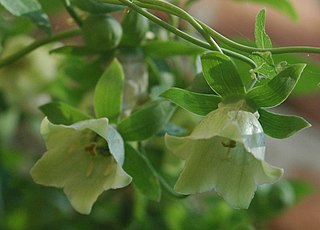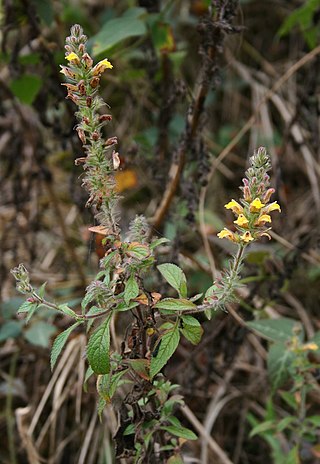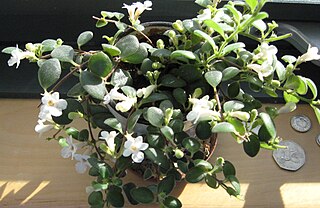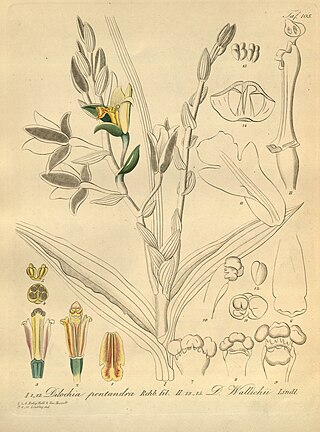
The Cucurbitaceae, also called cucurbits or the gourd family, are a plant family consisting of about 965 species in 101 genera. Those of most agricultural, commercial or nutritional value to humans include:

Uncaria is a genus of flowering plants in the family Rubiaceae. It has about 40 species. Their distribution is pantropical, with most species native to tropical Asia, three from Africa and the Mediterranean and two from the neotropics. They are known colloquially as gambier, cat's claw or uña de gato. The latter two names are shared with several other plants. The type species for the genus is Uncaria guianensis.

In the botanical classification of plants, Aeridinae Pfitzer is a subtribe of the tribe Vandeae whose representatives all have a monopodial growth habit and do not possess pseudobulbs.

The Annonaceae are a family of flowering plants consisting of trees, shrubs, or rarely lianas commonly known as the custard apple family or soursop family. With 108 accepted genera and about 2400 known species, it is the largest family in the Magnoliales. Several genera produce edible fruit, most notably Annona, Anonidium, Asimina, Rollinia, and Uvaria. Its type genus is Annona. The family is concentrated in the tropics, with few species found in temperate regions. About 900 species are Neotropical, 450 are Afrotropical, and the remaining are Indomalayan.

Hoya is a genus of over 500 accepted species of tropical plants in the dogbane family, Apocynaceae. Most are native to several countries of Asia such as the Philippines, India, Thailand, Malaysia, Vietnam, Bangladesh, Indonesia, Polynesia, New Guinea, and many species are also found in Australia.

Campanula is the type genus of the Campanulaceae family of flowering plants. Campanula are commonly known as bellflowers and take both their common and scientific names from the bell-shaped flowers—campanula is Latin for "little bell".

The family Campanulaceae, of the order Asterales, contains nearly 2400 species in 84 genera of herbaceous plants, shrubs, and rarely small trees, often with milky sap. Among them are several familiar garden plants belonging to the genera Campanula (bellflower), Lobelia, and Platycodon (balloonflower). Campanula rapunculus and Codonopsis lanceolata are eaten as vegetables. Lobelia inflata, L. siphilitica and L. tupa and others have been used as medicinal plants. Campanula rapunculoides may be a troublesome weed, particularly in gardens, while Legousia spp. may occur in arable fields.

Breynia is a genus in the flowering plant family Phyllanthaceae, first described in 1776. It is native to Southeast Asia, China, Réunion, the Indian Subcontinent, Papuasia and Australia.

Codonopsis is a genus of flowering plant in the family Campanulaceae. As currently recognized, Codonopsis includes two other groups sometimes separated as distinct genera, i.e. Campanumoea and Leptocodon. The enlarged genus Codonopsis is widespread across eastern, southern, central, and southeastern Asia, including China, Japan, the Russian Far East, Kazakhstan, the Indian Subcontinent, Iran, Indochina, Indonesia, etc.

Lindenbergia is a genus of herbaceous plants in the order Lamiales and in the broomrape family Orobanchaceae. It is one of the few genera of the family which are not parasitic. It contains about 15 species found from northeast Africa across Asia to the Philippines, and is most abundant in India.
Trivalvaria is a genus of plant in family Annonaceae. It is found in Tropical Asia including Hainan.

Heterocodon is a monotypic genus of plants in the bellflower family containing the single species Heterocodon rariflorum, which is known by the common names rareflower heterocodon and western pearlflower. It is native to western North America from British Columbia to California to Colorado, where it emerges during the spring in wet areas such as meadows. This is an annual herb producing a very thin, erect stem to 30 centimeters in maximum height. It branches few times if at all and is dark green to reddish in color. Leaves are occasional along the stem and are heart-shaped to rounded with a toothed edge. Also at occasions along the stem are the flowers, which emerge from a base of toothed or spiny leaflike sepals a few millimeters long. The corolla of the flower is a cylindrical tube 3 to 5 millimeters long, blue or lavender with darker veining and a lighter throat, and spreading into triangular lobes at the mouth.

Codonanthe is a genus of mainly epiphytic plants in the family Gesneriaceae, endemic to the Atlantic Forest of Brazil. The botanical name comes from the Ancient Greek for 'bellflower'. They have white or pale pink flowers and somewhat fleshy leaves. In 2013, the genus was reduced in size when more than half of the species were transferred to Codonanthopsis. They can be grown as houseplants, particularly in hanging baskets. Artificial crosses with Nematanthus hybrids have produced the hybrid genus × Codonatanthus.

Dilochia is a genus of flowering plants from the orchid family, Orchidaceae. It contains 8 known species, native to Southeast Asia and New Guinea.
- Dilochia beamaniiOrmerod - Borneo(Sabah)
- Dilochia cantleyi(Hook.f.) Ridl. - Indonesia, New Guinea
- Dilochia carnosaSulist. - Indonesia(Sumat ra)
- Dilochia celebica(Schltr.) Schltr. - Sulawesi
- Dilochia deleoniaeTandang & Galindon - Philippines
- Dilochia elmeriAmes - Philippines
- Dilochia longilabrisJ.J.Sm. - Sulawesi, Borneo
- Dilochia parvifloraJ.J.Sm. - Borneo
- Dilochia rigida(Ridl.) J.J.Wood - Sabah
- Dilochia subsessilis(Rolfe) S.Thomas - Myanmar
- Dilochia wallichiiLindl. - Thailand, Malaysia, Indonesia, New Guinea, Philippines

Bistorta is a genus of flowering plants in the family Polygonaceae. As of February 2019 about 40 species are accepted. It has been supported as a separate clade by molecular phylogenetic analysis. Bistorta species are native throughout much of the Northern Hemisphere, as far south as Mexico in North America and Thailand in Asia.

Ericoideae is a subfamily of Ericaceae, containing nineteen genera, and 1,790 species, the largest of which is Rhododendron, followed by Erica. The Ericoideae bear spiral leaves with flat laminae. The pedicel is articulated and the flowers are pendulous or erect, and monosymmetric, with an abaxial median sepal. The carpels are free and the anthers lack appendages. The capsule is septicidal.

Sulla is a genus of flowering plants in the legume family, Fabaceae. It includes eight species of annual herbs native to the Mediterranean Basin, including southern Europe, North Africa, and western Asia. They grow in dry Mediterranean-climate shrubland, bushland, thicket, and grassland and in semi-desert. The genus belongs to subfamily Faboideae.

The Malmeoideae are a subfamily of trees and other plants of the family Annonaceae.
Cyclocodon is a genus of flowering plants belonging to the family Campanulaceae.

Neanotis is a genus of flowering plants belonging to the family Rubiaceae, and the major group Angiosperms.


















